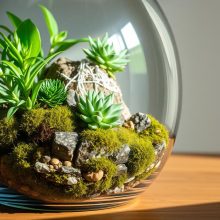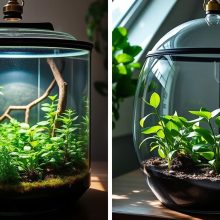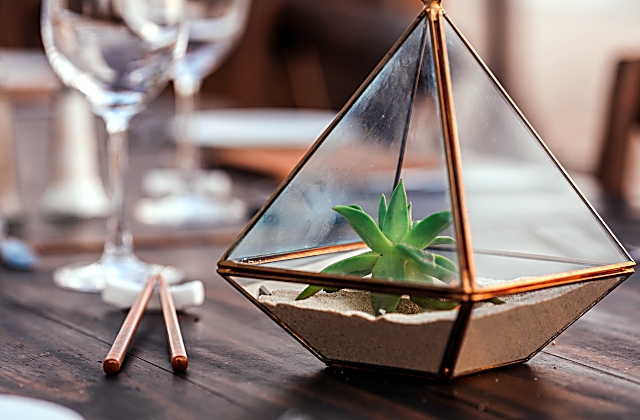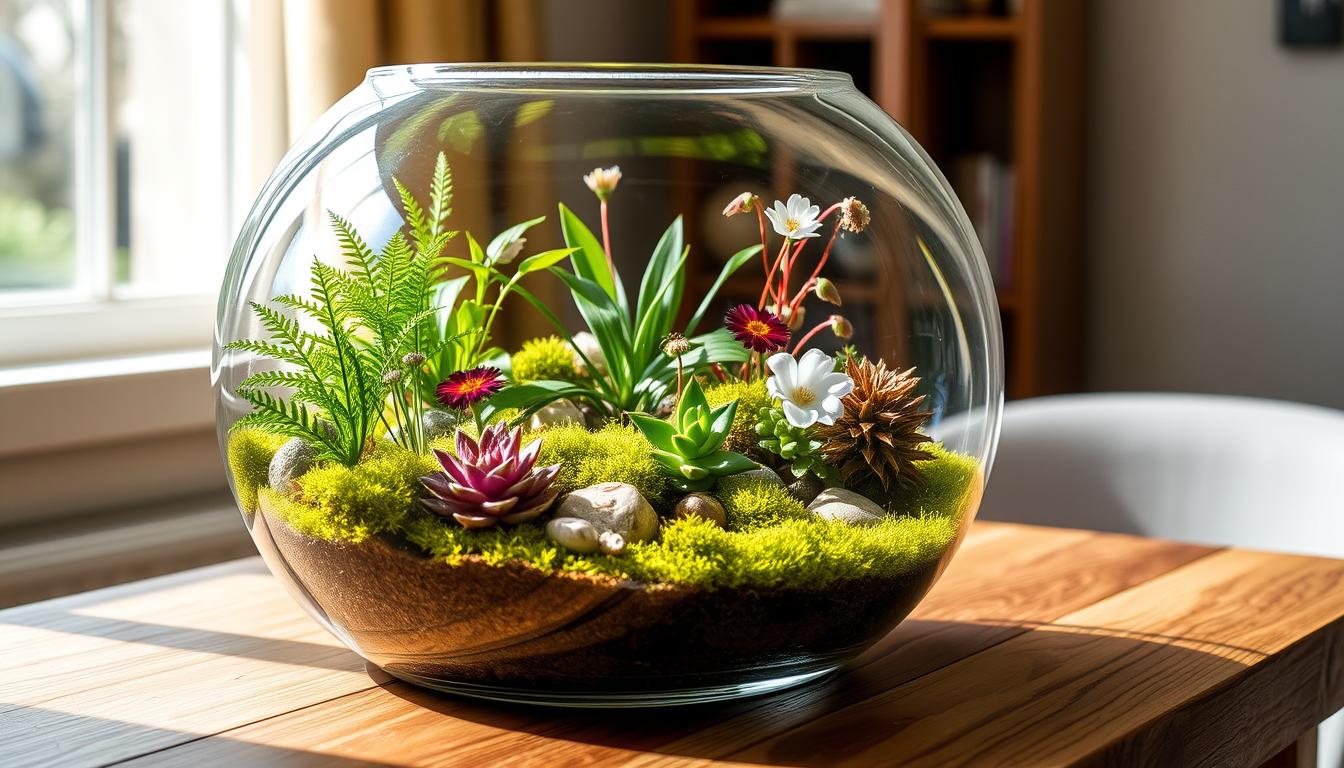Stunning Terrarium Design Ideas to Transform Your Space
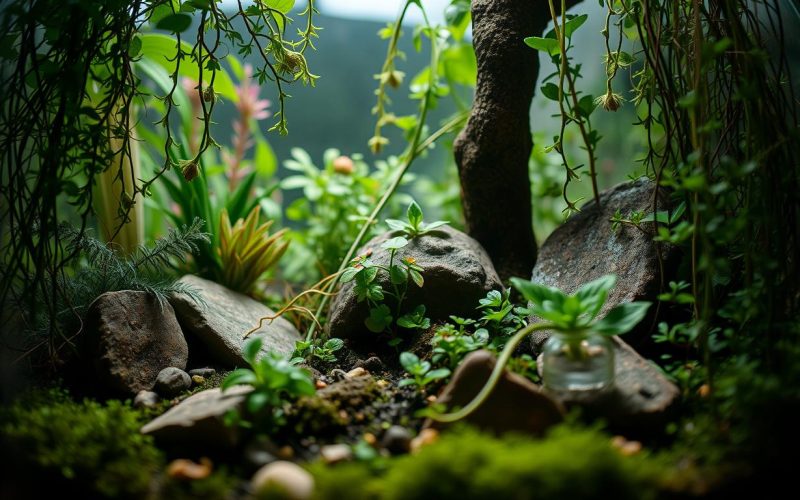
Indoor gardening has grown beyond just houseplants. Terrarium design ideas bring nature into our homes in a new way. These small ecosystems turn ordinary rooms into lively, green spaces.
Terrariums are more than plants in a container. They mix art, science, and design. Whether you love plants or enjoy DIY projects, terrariums offer a fun way to change your home’s look.
These mini gardens come in all shapes and sizes. They fit any home style, from simple to rustic. Terrariums let you express yourself in a unique way.
Key Takeaways
- Terrariums transform interior spaces with unique botanical displays
- Perfect for both experienced gardeners and creative beginners
- Offers flexible design options for different home styles
- Provides an innovative approach to indoor gardening
- Creates living art pieces that enhance home decor
Why Terrariums are the Perfect Indoor Decoration
Terrariums have changed how we decorate our homes, turning ordinary spaces into green havens. These small worlds add life and energy to any room. They are a unique way to bring plants into your home, loved by both plant fans and design enthusiasts.
Compact and eye-catching, terrariums are a smart choice for adding nature to your home. They do more than just look good; they’re a smart pick for modern homes.
Benefits of Having a Terrarium
- Low maintenance compared to traditional houseplants
- Space-efficient design for small apartments and offices
- Natural air purification and humidity regulation
- Stress-reducing and therapeutic plant care experience
These mini gardens create humid environments that are great for tropical plants. They let plant lovers enjoy greenery without needing to be garden experts.
A Touch of Nature in Any Room
Terrariums fit well with many home styles. They work with minimalist, bohemian, or modern decor. They turn empty spots into beautiful green highlights.
- Ideal for home offices
- Perfect living room centerpieces
- Elegant bedroom decor accents
Adding terrariums to your home is more than just decorating. It’s creating a living piece of art that brings your home to life.
Essential Elements of Terrarium Design
Creating a stunning terrarium needs careful thought about key design elements. Glass container gardening brings nature indoors, turning small spaces into living art. Knowing the basic parts helps you make a beautiful, thriving mini-ecosystem.
Containers: Selecting the Perfect Home
Finding the right container is key in glass container gardening. Look for ones that fit your space and let plants grow. Here are some options:
- Clear glass jars with wide openings
- Geometric glass terrariums
- Vintage glass containers
- Repurposed glass bottles
Soil and Drainage Strategies
Right soil layering is vital for terrarium health. Build a layered base that supports plant growth:
- Small pebble drainage layer
- Activated charcoal for filtration
- Specialized terrarium soil mix
- Decorative top layer
Selecting Your Green Companions
Choosing the right plants is crucial. Pick ones that need similar water and light. Succulents are great for easy care, while tropical plants add lush, vibrant scenes.
Pro tip: Mix textures and heights for visual interest. Aim for a balanced look that feels natural.
DIY Terrarium Projects for Beginners
Starting your own indoor garden is easy with DIY terrarium projects. These small worlds bring nature indoors and let you show your creativity. They’re perfect for anyone who loves plants or is just starting out.
To begin with DIY terrariums, you need some basic knowledge and materials. Here’s how to make your first beautiful mini garden:
Step-by-Step Terrarium Creation Guide
- Gather your materials:
- Clear glass container
- Small rocks or pebbles
- Activated charcoal
- Potting soil
- Selected plants
- Create a drainage layer using rocks
- Add a thin layer of activated charcoal
- Fill with appropriate potting soil
- Carefully plant your selected greenery
- Add decorative elements if desired
Common Mistakes to Avoid
Creating a beautiful indoor garden means knowing what not to do. Here are some big mistakes to avoid in your DIY terrarium projects:
- Overwatering plants
- Selecting incompatible plant species
- Ignoring proper drainage
- Placing terrarium in incorrect lighting conditions
Pro tip: For succulent terrariums, use minimal water and ensure excellent drainage to prevent root rot. Choose plants that like the same light and moisture to keep your mini garden happy.
Creative Terrarium Themes to Explore
Terrariums are a blank canvas for creativity. They turn small areas into mini gardens that spark the imagination. Each theme has its own story, bringing different worlds into your home.
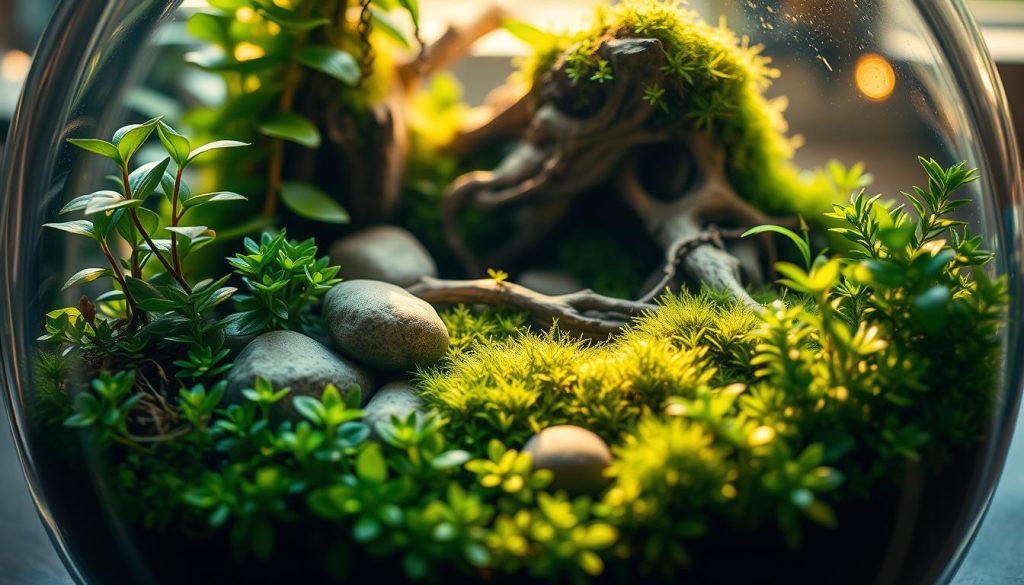
Miniature Forest Terrariums
Miniature forest terrariums bring woodland magic to small spaces. Choose plants like moss, ferns, and tiny ground covers for a lush forest floor. Add miniature rocks, bark, and layers for depth and texture.
- Use compact moss varieties
- Select small fern species
- Add miniature landscape elements
Desert Vibes: Succulent Terrarium Ideas
Succulent terrariums can turn your space into a desert wonderland. Use warm sand, different gravel layers, and drought-resistant plants for a real desert feel.
- Layer fine sand and pebbles
- Select diverse succulent types
- Use earthy color palettes
Tropical Paradise in a Jar
Tropical terrariums bring a lush, vibrant feel to your home. Choose plants like small orchids, miniature palms, and colorful leaves for a dense, green space.
- Include moisture-loving plants
- Create humid microclimate
- Use varied green textures
Utilizing Lighting to Enhance Your Terrarium
Lighting is key in making your terrarium stand out. It brings your indoor garden to life. The right light ensures your plants stay healthy and look great.
To create the perfect terrarium, know what light your plants need. Each plant has its own light requirements. This affects how they grow and look.
Natural Light Considerations
- Check your home’s natural light patterns
- Place terrariums near windows with soft sunlight
- Rotate terrariums for even light
Artificial Lighting Options
If natural light is scarce, artificial lighting is a must. LED grow lights are great for terrariums. They offer:
- Consistent light intensity
- Low heat emission
- Energy-efficient
- Customizable spectrum for plants
Succulents need direct light, while tropical plants prefer soft, filtered light. Knowing this helps you create a thriving indoor garden.
Choosing the Right Location for Your Terrarium
Finding the perfect spot for your terrarium is key. It should look great and keep your plants healthy. Terrariums are now a big part of home decor, adding beauty to any room.
Where you place your terrarium matters a lot. It affects how it looks and how well your plants do. Choosing the right spot is all about creativity and careful thought.
Indoor Terrarium Placement Strategies
- Windowsills with filtered light
- Shelves away from direct heat sources
- Coffee tables as centerpiece displays
- Hanging options for compact spaces
Outdoor Terrarium Design Considerations
Outdoor terrariums offer a chance to take your decor to the next level. Use weather-proof containers and pick the right spot to keep your plants happy outside.
- Select sheltered areas with partial shade
- Use protective coverings during extreme weather
- Choose hardy plant varieties
- Monitor humidity and temperature fluctuations
Every spot has its own perks for your terrarium. It’s all about finding the right balance between looks and plant health.
Terrarium Accessories to Elevate Your Design
Creating stunning terrarium decoration inspiration is more than picking plants. The right accessories can make your miniature garden designs pop. They turn simple displays into captivating landscapes with a unique story.
Accessories are key to bringing your terrarium to life. They add depth, character, and visual interest to your miniature world.
Decorative Stones and Pebbles
Choosing the perfect stones can greatly enhance your terrarium’s look. Here are some options for terrarium decoration inspiration:
- River rocks in varying sizes and colors
- Polished quartz crystals
- Volcanic stones for texture
- Smooth beach pebbles
Stones not only look good but also help with drainage. They create interesting spaces within your terrarium and complement the plants.
Figurines and Miniature Decorations
Small figurines can make your terrarium whimsical. When picking decorations, remember these tips:
- Choose pieces that fit your terrarium’s theme
- Make sure figurines are the right size for your container
- Opt for weatherproof materials
- Avoid too many decorations
From tiny ceramic animals to miniature structures, these decorations can create stories. They turn your terrarium into a captivating miniature world.
Advanced Techniques in Terrarium Design
To make your terrarium stand out, you need creativity and a plan. Advanced terrarium designs go beyond simple plant setups. They turn small glass worlds into stunning miniatures. Experts see terrariums as an art, where every detail matters.
Learning advanced terrarium techniques means mastering layering. Designers use smart layering to add depth and interest:
- Use varied substrate colors to create dramatic contrasts
- Experiment with multi-level plant placements
- Integrate different textures and materials
- Create micro-landscape environments
Layering Plants and Colors
Good terrarium designs use color and plant layering wisely. Start with dark substrates, then add light gravels and sands. Choose plants that match in color to add depth. Place small plants up front and tall ones in the back for a 3D look.
Incorporating Water Features
Adding water can make a terrarium truly special. Small fountains or ponds bring life and create unique spots. Experts suggest sealed areas and plants that like moisture for water features to work well.
Considering Maintenance for Your Terrarium
Creating a stunning indoor garden is more than just the initial design. Proper maintenance is key to keeping your terrarium healthy and vibrant. Terrariums are delicate ecosystems that need careful attention to thrive and maintain their beauty.
Successful succulent arrangement tips start with understanding your plants’ unique needs. Different terrarium environments demand distinct care strategies to ensure long-term plant health.
Watering Tips for Different Plants
Watering your terrarium requires precision and knowledge. Different plants have varying moisture requirements:
- Desert plants like succulents need minimal water
- Tropical plants require consistent moisture
- Use a small straw for targeted watering in tight spaces
- Check soil moisture before adding water
Pest Control and Plant Care
Maintaining a healthy terrarium involves proactive pest management and careful observation. Watch for these potential issues:
- Inspect plants weekly for signs of insects
- Remove dead or decaying plant material promptly
- Use natural pest control methods like neem oil
- Ensure proper air circulation to prevent mold growth
Your indoor garden inspiration can remain beautiful with consistent, mindful care. By understanding your terrarium’s unique ecosystem, you’ll create a thriving miniature landscape that brings nature indoors.
Terrariums as Unique Gifts
Finding the perfect gift can be tough. But DIY terrarium projects are a creative and personal way to delight anyone. They’re not just decorations; they’re living gifts that show you care and are artistic.
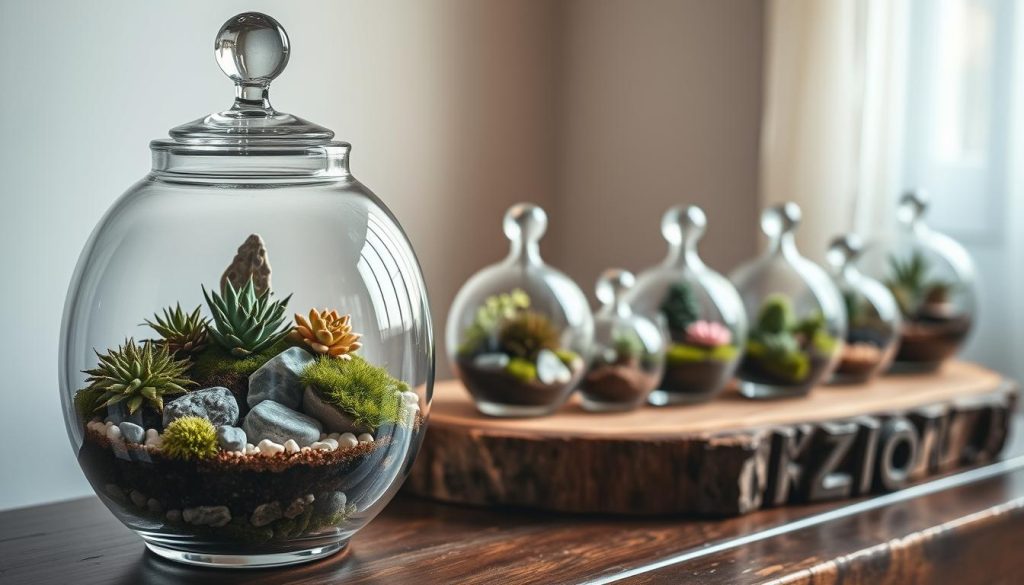
Decorating terrariums can turn a simple gift into a special experience. Use small containers like vintage shot glasses, mason jars, or elegant glass vases. They make great bases for tiny green worlds that spark the imagination.
Personalized Terrarium Design Ideas
Creating a meaningful terrarium gift means knowing the person you’re giving it to. Think about these ideas:
- Career-themed terrariums with tiny work elements
- Color-coordinated designs that match their home
- Hobby-inspired landscapes with tiny details
- Memory-based terrariums that represent special moments
How to Gift a Terrarium Experience
You have two great ways to give a terrarium:
- Give a pre-assembled terrarium to display
- Give a DIY terrarium kit with instructions and materials
The DIY kit lets the recipient enjoy making it, making the gift interactive and memorable. Terrarium decoration ideas can come from personal connections, making the gift even more special.
Eco-Friendly Terrarium Options
Glass container gardening has become a green art form. It lets plant lovers make stunning ecosystems with little harm to the environment. Today, terrariums are a top choice for those who want to be creative and care for the planet.
To make an eco-friendly terrarium, pick materials and plants wisely. These choices can turn your small garden into a symbol of caring for our planet.
Sustainable Plant Choices
When making your terrarium, choose plants that need less and grow well in small spaces:
- Moss varieties that spread easily
- Compact succulents that use less water
- Local plants that fit your climate
- Air plants that need little soil and care
Upcycling Materials for Your Terrarium
Get creative by turning common items into unique terrarium homes. Here are some cool ideas:
- Use old mason jars as terrariums
- Make mini gardens from vintage light bulbs
- Clear wine bottles work great for tall terrariums
- Turn old glassware into beautiful plant showcases
By using these green ideas, you’ll make not just a pretty terrarium but also help the planet. It’s a win-win for both your home and the environment.
Showcasing Your Terrarium in Different Settings
Terrariums turn ordinary spaces into stunning indoor gardens. They bring life and beauty to various rooms. This makes them perfect for adding a touch of nature indoors.
In home offices, terrariums do more than look good. They help reduce stress and improve focus. A small terrarium on your desk can add a calming green touch to your workspace.
Living rooms get a boost from large terrariums. They become the center of attention, with their detailed landscapes and unique plants. Placed on coffee tables or side consoles, they show off your style and love for plants.
Bedroom nightstands are great for small terrariums. They add a peaceful touch with soft green plants. These terrariums connect you to nature without taking up too much space.
